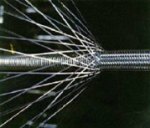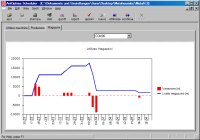|
Industrial Problem: Hoses Production Optimization (HoP)
Industrial Problem: Hoses Production Optimization (HoP)
edited by David Huber, AntOptima
Contents
Introduction
 The problem under investigation is about the optimization of hoses production (HoP for short)
in an important Italian factory for which AntOptima made a preliminary feasibility study. The HoP is
a scheduling problem that is defined by a set of real orders to be executed by a group of multi-purpose
machines. Typically, for each input data there are 300 orders consisting of about 800'000 meters of hoses.
Each input data specifies the production of about one month. For each order there are constraints and
requirements that must be satisfied (like deadlines, raw materials demand, precedence constraints,
priorities, etc.). The production must be scheduled on 35 machines with different characteristics and
requirements. The goal is to organize the production without violating the "main" constraints and minimizing
an objective function that takes into consideration several aspects such as the penalties of violating
constraints, the customers' priorities, and so on.
The problem under investigation is about the optimization of hoses production (HoP for short)
in an important Italian factory for which AntOptima made a preliminary feasibility study. The HoP is
a scheduling problem that is defined by a set of real orders to be executed by a group of multi-purpose
machines. Typically, for each input data there are 300 orders consisting of about 800'000 meters of hoses.
Each input data specifies the production of about one month. For each order there are constraints and
requirements that must be satisfied (like deadlines, raw materials demand, precedence constraints,
priorities, etc.). The production must be scheduled on 35 machines with different characteristics and
requirements. The goal is to organize the production without violating the "main" constraints and minimizing
an objective function that takes into consideration several aspects such as the penalties of violating
constraints, the customers' priorities, and so on.
Problem definition
 In the HoP problem we have a set of customers orders. Each order is defined by the type of hose to be
produced, by the quantity, by a deadline time and by a release time (the release and the deadline define
the production time window).
In the HoP problem we have a set of customers orders. Each order is defined by the type of hose to be
produced, by the quantity, by a deadline time and by a release time (the release and the deadline define
the production time window).

Fig. 1: a braiding machine
The set of orders is partitioned into a set of n Jobs
J = {J1,...,Jn} according to the hose type
(from a set T = {T1,...,Tj} of types), order
deadline-release and machine production slot (the latter is the discrete minimal amount of hoses that a
machine can produce). Moreover, we have a set of m machines
M = {M1,...,Mm} that are used for the hoses
production (a machine example is shown in fig. 1). Each job of type
Tj must be processed, without interruptions, by a machine
k out of a set Mj of given machines from
M. The subset Mj is defined according to
technological constraints.
Other constraints of the problems are listed below.
- (MACHINE-BREAK-TIME) Machines cannot work always, machine-break-time (for maintenance, breakage,
strike, etc.); A job cannot be scheduled on a machine during its
machine-break-time.
- (SLOT) For each hose type t and each machine m, it is defined a
minimal discrete amount of production that is called slot s
(the amount of hose type t that can be produced by machine
m is a multiple of s).
- (PROCESSING TIME) The processing time of job Ji on machine
k is a given positive value pik that
depends on the speed of the machine, on the hose type and on the quantity to be produced.
- (TIME-WINDOW) Jobs have starting and end time windows. A job Ji
should be processed during the time window
[releasei, deadlinei]. Violations of the time window
are allowed, with penalties, only for the completion time.
- (SET-UP) Before processing a job on a machine, the chosen machine must be equipped, the time to
make the latter is called setup time. Job Ji
on machine k requires a setup time which depends on its type, on the type of its
machine predecessor and on the machine itself.
- (FROZEN JOBS) A job Ji can be frozen on a given machine
k at a specific time si.
Objective function
The goal is to choose, for each jobs Ji, a machine
k of Mi and a starting time
si so that the weighted combination of:
- maximum completion time (makespan),
- sum of all jobs tardiness,
- sum of all setup times and
- difference of machine completion times
is minimized.
Metaheuristics
The environment implements the following search algorithms:
- Ant Colony Optimization
- Evolutionary Computation
- Iterated Local Search
- Simulated Annealing
- Tabu Search

User interface
We implemented a Graphical environment for the management of schedules.
The user can build, search and edit solutions interactively through a simple yet powerful interface.
Data is loaded from a local or remote database.
Many constraints, like machine-break-times, frozen states, time windows, ecc. can be changed at runtime.
This allows operators to simulate different scenarios and evaluate warehouses occupations.
| 








